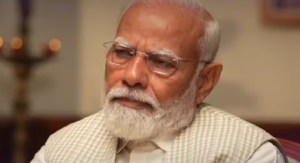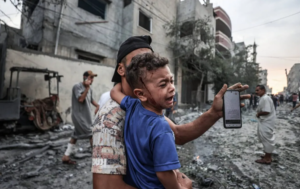On 24 September 2012, 26 people from six Buddhist families converted to Islam in the Zanskar valley in Ladakh, in India’s far north. The converts were from oppressed castes and wanted to break free from the discrimination that they experienced daily. The local market was filled with Muslims celebrating the event. Their jubilation made the Buddhists in the Zanskar valley angry.
In the aftermath of the celebrations, Buddhists forced a shutdown of the market. They were led by the Zanskar Buddhist Association (ZBA), which wrote to local Muslim leaders threatening further protests if conversions did not stop. The ZBA expressed scepticism that such a large number of conversions could have happened at once with the free agreement of the converts. There were whispers about coercion, which the converts and Muslim community leaders denied. Tensions built up until a mod of Buddhists attacked the Muslims, leaving dozens of people injured. Muslim houses were damaged and property worth thousands of rupees was destroyed.
The attackers demanded “custody” of the new converts. Though one family succumbed to pressure and vowed to renounce Islam, others stood firm in their newfound faith. The standoff had a lasting impact on local interfaith relations, with Buddhists initiating a social boycott of Muslims – they refused to deal with any Muslims traders, shops or workers – that continued for six years. It ended only in 2018, after the Dalai Lama intervened and representatives from both communities formed a peace committee at his behest.
Ladakh is today a Union Territory of India, situated in a high-altitude desert. It has a mixed population of Buddhists, Muslims and Hindus living in the districts of Leh and Kargil. About 46 percent of the population are Muslim, while 40 percent are Buddhists and 12 percent Hindus. Leh district, bordering China, is dominated by Buddhists, who comprise around two-thirds of its population; Kargil district, bordering Pakistan, is mainly inhabited by Muslims, who make up over a quarter of its residents.
The violence in Zanskar in 2012 was not the first such incident. Communal divisions have long plagued Ladakh. According to Tsering Phuntsog, the former general secretary of the Ladakh Buddhist Association, conflict between Buddhists and Muslims here started over the construction of a gompa, or Buddhist monastery, on government-allocated land in Kargil. The government of Jammu and Kashmir, then still a full-fledged state of India that included Ladakh, sanctioned building the gompa in 1961, but construction stopped abruptly in 1969.
“Buddhists alleged that it was due to the Muslim influence that the status for gompa construction was changed by the Jammu and Kashmir government,” Phuntsog explained. “Since then, the two communities had never seen eye to eye.”
In 1989, the Ladakh Buddhist Association ordered a social boycott of Muslims after communal violence arising out of a scuffle between a Buddhist youth and four Muslims. The unofficial embargo lasted until November 1992. More recently, in 2017, the relationship between Ladakh’s Buddhists and Muslims was strained by allegations of “love jihad”– an Islamophobic conspiracy theory, pushed especially by rightwing Hindu groups, about Muslim men converting non-Muslim women through marriage. This came after a Buddhist woman from Leh married a Muslim man from Kargil.
In 2019, the ruling Bharatiya Janata Party (BJP) government revoked Article 370 of the Indian constitution, removing the limited autonomy that had earlier been granted to Indian-administered Kashmir and stripping Jammu and Kashmir of statehood. As part of this, Ladakh was recognised as a separate Union Territory, without its own legislature and under the administration of the incumbent Hindu nationalist government in New Delhi.
The abrogation of Article 370 dismembered India’s only Muslim-majority state. While the Muslim-dominated Kashmir Valley was vehemently against the move, Ladakh had a more mixed reaction. Many Buddhist residents of Leh cautiously welcomed the decision, hoping that Buddhist-majority Ladakh would eventually be granted greater autonomy. Many in Muslim-dominated Kargil felt differently. But five years later, in the spring of 2024, the Buddhists of Leh and the Muslims of Kargil stood together to protest against the central government in New Delhi headed by Narendra Modi.
Thousands of people, including women and children, joined protest rallies in Kargil and Leh, sleeping under the open sky despite temperatures of minus 15 degrees Celsius. In Leh, hundreds of women held a ten-day fast at the Nawang Dorjay Stobdan Memorial Stupa. They were followed by a group of youths holding a hunger strike, and they were followed in turn by Buddhist monks. In Kargil, more than two hundred kilometers west of Leh, protesters also observed a three-day fast, following a half-day shutdown earlier. The protesters frequently chanted slogans against the BJP government in New Delhi for failing to fulfill its promises of granting Ladakh more autonomy. Their demands were for Ladakh to be made a state, with protections against an influx of outsiders that would keep government jobs, land and other resources in Ladakhi hands.
In 2020, Buddhists realised that the abrogation of Article 370 was “part of a larger governmental strategy of disenfranchising Ladakhis in their homeland,” Phuntsog said. “Buddhist religious leaders decided to come together with Muslims, end their religious feud and stay together for the larger issue that concerned Ladakh.” That year, the Leh Apex Body (LAB) and Kargil Democratic Alliance (KDA) came together for the first time to jointly protest against the Modi government.
The climate activist Sonam Wangchuk during his 21-day climate fast in March 2024. Ladakh’s residents fear for the region’s fragile ecology if outsiders are given easy access to settle and build here.
The protesters laid out a set of four broad demands: statehood for ladakh; safeguards under the sixth schedule of the indian constitution, which allows for special autonomous bodies with legislative and judicial authority in areas with tribal populations; an early recruitment process for government jobs allowing for local representation; and a parliamentary seat each for leh and kargil. The protests were the culmination of mounting post-Article 370 frustrations. The Indian central government had constituted a committee to address Ladakh’s grievances in 2023, but more than a year of negotiations for greater autonomy and political representation have yielded no results.
The protesters included disenchanted members of the Ladakh Buddhist Association. One of them was Chering Dorjay, the former BJP chief for Ladakh. He complained that the Ladakhi population has no say in its own governance, with all decisions being made at the behest of the Lieutenant Governor for Ladakh, who is appointed by the central government.
Kargil residents argue that they were better off integrated with Muslim-majority Jammu and Kashmir, as their rights were safeguarded under Articles 370 and 35-A of India’s constitution, which barred people from other Indian states from buying property, living in or working in Ladakh. This provided protection for the local population, which suffers from a dearth of amenities and employment opportunities, and local land with limited productivity.
“Since Article 370’s revocation, we have been besieged with challenges,” said Bashir Ahmed Shakiri, who heads the Imam Khomeini Memorial Trust, a religious seminary in Kargil. He said that “outsiders now eye local job opportunities, and our educated youth are left empty-handed.”
Shakiri argued that, initially, Leh’s argument for separation from Kashmir was framed along religious lines: on the division between Muslims and Buddhists. He explained that the Rashtriya Swayamsevak Sangh, the parent body of the BJP, as well as Leh’s populace, “had a desire to supplant a Muslim-majority state with a Muslim chief minister. Their aspiration for a separate region, despite our apprehensions, materialised, and now, even they are protesting.”
Feroz Ahmed Khan, the former chief executive councilor of the Ladakh Autonomous Hill Development Council of Kargil, one of two autonomous district councils that administers the Kargil district, agreed that there was widespread fear among the people that they no longer had protection for their land, jobs and culture. As an alternative, he said, locals have been pushing for protection for Ladakh under the Sixth Schedule of the constitution, so far with limited success.
Under the Sixth Schedule, local councils would be empowered to enact regulations on land, forestry, sanitation, agriculture and health. The provision is already applicable in parts of other Indian states including Assam, Meghalaya, Tripura and Mizoram. Ladakh, which has a tribal population of 97 percent, should qualify for Sixth Schedule protections, since these can only be applied where at least 50 percent of the state population is from tribal communities. But those involved in the negotiations with New Delhi say that the central government is not budging. “The government made it clear that they aren’t going to provide us with the Sixth Schedule,” said Sajad Kargili, a KDA member who participated in a meeting held with the government this March. This has led Ladakhis to believe that the central government, along with large corporations, has its eyes set on their land.
Padma Stanzin, a student activist from Leh, was adamant that Ladakh deserved protection under the Sixth Schedule, noting that this would help the region safeguard its indigenous culture and religion, as well as its ecology and glaciers. Stanzin said Leh had supported and voted for the BJP in the 2019 Indian general election because it had repeatedly pledged to grant Sixth Schedule status to Ladakh. The party’s candidate won the parliamentary seat from Ladakh that year. “However, in the past five years, they have done nothing but harm Ladakh,” he said. When India voted again this year, Ladakh elected an independent candidate, with the BJP’s vote share seeing a sharp drop.
The impacts of unplanned development and climate change are also of critical importance for residents of Ladakh. In March, Sonam Wangchuk, an award-winning educationist and climate activist, undertook a 21-day “climate fast” in freezing cold weather – only his latest act of protest to draw attention to the impact of climate change in Ladakh. Thousands of people joined him in his hunger strike, which ended on 26 March. “It is crucial that we safeguard these fragile regions as sacred zones of water. That is why we consider it very important to preserve this,” Wangchuk told reporters.
Ladakh is known for its glaciers and lakes, which serve as vital water sources for the area and beyond. The glaciers feed the Indus Basin, providing vital water for irrigation purposes. Himalayan glaciers like those in Ladakh have been rapidly receding due to global warming, and this ultimately impacts agriculture that sustains millions of people.
“Ladakh is ecologically sensitive and environmentally fragile,” said Asgar Ali Karbalai, a former member of the Jammu and Kashmir legislative assembly and the co-chairman of the KDA. “Imagine the repercussions if it is open to the 140-crore population of India.”
Ladakh is also strategically significant to india due to its proximity to both china and pakistan. China never recognised Ladakh’s status as a Union Territory after 2019 due to its own territorial claims to the area. Tensions between India and China have escalated sharply since 2020, after soldiers from both countries clashed in the Galwan valley, leaving 20 Indian soldiers dead. Since then, both countries have increased their troop numbers and military infrastructure along the disputed de facto border – the Line of Actual Control.
Indian opposition parties allege that China has encroached and taken over more than a thousand square kilometres of land in Ladakh – a claim that Narendra Modi has himself denied. Chinese soldiers often enter India’s territory and restrict locals from grazing their herds, adding to their grievances. Ladakh’s strategic positioning and these ongoing tensions with China could mean India is not willing to grant statehood to Ladakh, since statehood would mean New Delhi relinquishes some of its present control over the territory.
“The Indian state has always had a problem in granting a certain degree of autonomy to any region because of its primitive unitarian nature and a centralist tendency,” Noor Ahmad Baba, a political analyst based in Kashmir, said. “Similarly for Ladakh, the government would like to continue ruling it directly without granting statehood.” Above all, Ahmad Baba added, any logic by which Ladakh is granted statehood would naturally also apply to the rest of the former state of Jammu and Kashmir, which is also now a Union Territory – and a return of statehood in Jammu and Kashmir is not something New Delhi wants at the moment.
Siddiq Wahid, a political commentator and analyst based in Kashmir, said that New Delhi appeared to be underestimating the determination of the protesters in Ladakh, and the extent to which Ladakhis feel their language, culture, ecology and traditional vocations are under threat. “Ladakh is not arithmetically significant as a vote bank,,” he explained, and so poses no risk to the incumbent BJP’s electoral ambitions. – But, given that the region is contiguous with both China and Pakistan, it is puzzling that the Indian government is neglecting any resolution of the protests and refusing to grant Sixth Schedule protections,since this is only prolonging instability in a key border area.
Residents of Ladakh remain optimistic despite the BJP securing a third consecutive term at the head of the central government after the 2024 general election, making the fulfilment of their demands appear as challenging as before. The people are ready to take their protests forward regardless.“The ongoing agitation is a prolonged struggle where Ladakh has to contend a lot with the BJP, and we are fully prepared for such a fight,” Dorjay said.
“This cycle will continue,” agreed Wangchuk – a sentiment echoed by many other protesters too.
Qamar Ali Akhoon, a former minister of the Jammu and Kashmir state government and a co-chairman of the KDA, noted that the ongoing struggle for autonomy after the revocation of Article 370 had unexpectedly brought two antagonistic communities together. “When Muslim and Buddhist religious leaders stood together, it naturally brought the local people of both communities closer,” he said. “For them, nothing is more important than preserving Ladakh’s identity.”
Akhoon’s claim is substantiated by the fact that when the Buddhist monk Chokyong Palga Rinpoche campaigned to lay the foundation stone of a gompa in Kargil in 2022, there were no religious clashes or social boycotts, unlike on earlier such occasions. “The Ladakh Buddhist Association asked him not to proceed, as we were already in talks with the Kargil Democratic Alliance,” Tsering Phuntsog explained. “Given our unity with the Kargil Democratic Alliance, we couldn’t let the situation escalate.”. But there was no escalation. Instead, the Ladakh Autonomous Hill Development Council of Kargil gave its own land to Buddhists for the construction of the gompa. Such a solution would have been unthinkable before 2019.
(Zaid Bin Shabir and Auqib Javeed are independent journalists based in Jammu and Kashmir. Courtesy: Himal Southasian, Southasia’s first and only regional magazine of politics and culture. It seeks to be Independent, non-nationalist, pan-Subcontinental.)




